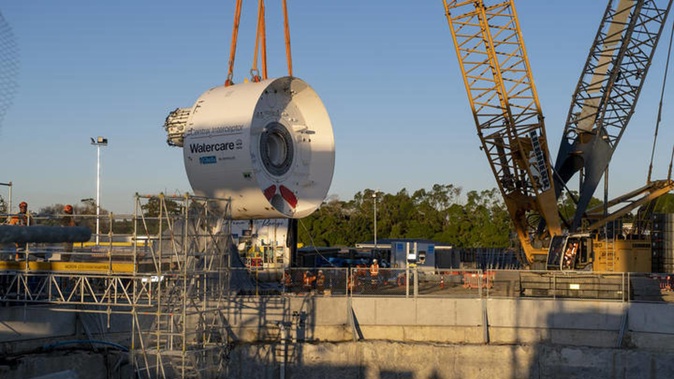
Omicron has stalled a giant tunnelling machine boring its way under Auckland.
The hold-up at Watercare's new Interceptor tunnel is just one casualty from the virus rampaging through the construction sector.
Shayne Cunis is overseeing putting in the supersized wastewater pipe and has had a tough two weeks.
"I didn't have any hair to start with to be fair, but I'd love to have a conversation that doesn't revolve around Covid most days," he told RNZ.
At his nine Interceptor projects, rapid antigen testing since Christmas began picking up more and more asymptomatic cases among workers.
He is now down a third of workers - more than twice as high as the 13 per cent rate across Watercare's other 25 construction projects - and almost all his two dozen tunnellers are off.
"It's probably not a surprise that people who spend 10 hours underground in fairly confined spaces, it spread amongst them, and that had an impact straight away."
It shut down the Hiwa-i-te-Rangi (tunnel boring machine) nine days ago, the first time it has stopped since it began tunnelling last July.
"But the good side of that is that they'll all be coming back to work in the next few days," Cunis said.
He expects to restart at least one crew this week.
Meanwhile, across town, heatpump and ventilation firm Heatwave has a third of its 35 staff off.
If managing director Grant Price loses just one more of his project managers, "I suppose I'll step in", he said.
"We've got four project managers and three of them are off.
"So we've got some of the engineers in the office assisting.
"The one project manager standing ... is trying to keep each of those projects moving forward."
Subbies and main contractors were hopping from site to site, "patching" projects to keep them at least somewhat on track, instead of being assigned to a single site, said Price, who is also president of the Specialist Contractors Federation.
"You have to keep running back to it."
He has heard that at many Auckland firms, a third of subbies are off sick or isolating.
This was disrupting entire teams that might need all their crew on deck to operate safely, such as for roofers.
It also cuts revenues and required careful money management, he said.
"They either have to pull to their horns in, and not bid so much work ... or they have to patch around to manage it.
"And what's happening now with Covid is giving us an example of what, if that labour shortage continues, it might be like ... people are unsettled."
Auckland builder NZ Strong has more than 100 staff, and half are off.
"And it would be the same percentage for all our subs," director Chris Hunter said.
"[It's] very hard to get any back-up labour as every company [was] struggling to get enough labour prior to this Covid surge."
As for road and infrastructure building, the industry group Civil Contractors NZ estimated 10 to 30 per cent of workers nationally were stuck at home.
"We've got mechanisms in place to try and get people back quickly," said chief executive Alan Pollard.
"One of the challenges we're seeing though, is there's no consistent interpretation of what represents a critical business or a critical role.
"What might be critical for some, doesn't appear to be critical for others and that's creating some real challenges around deciding how do we address the safety and protection aspect and get people back as quickly as we can."
Sharp and short
Industry crystal ball gazers are holding out hope the Omicron rampage might be sharp, and short.
Independent construction cost advisory RLB Auckland managing director Stephen Gracey said analysis of Australia's experience backed this up.
"Whilst it's impacting everyone, to a greater or lesser extent, it does seem to have blown through the Australian construction sector fairly quickly.
"It's two to three months, and at its peak, it was probably 40 per cent but I think on average over a two or three-month period it's 20 to 30 per cent loss of productivity."
Australia had already emerged from the other side.
"That's what we can expect," Gracey said.
Supply chain pressures would continue though.
RLB calculated those pressures and the tight labour had helped push up overall commercial building costs 8 to 10 per cent in the past year.
It forecasts that to slow to 5 to 6 per cent this year - with residential inflation expected to be similar.
Meantime though, Gracey said there just were not enough pickers and packers to get even such basic products as plasterboard to market.
Take your Radio, Podcasts and Music with you









